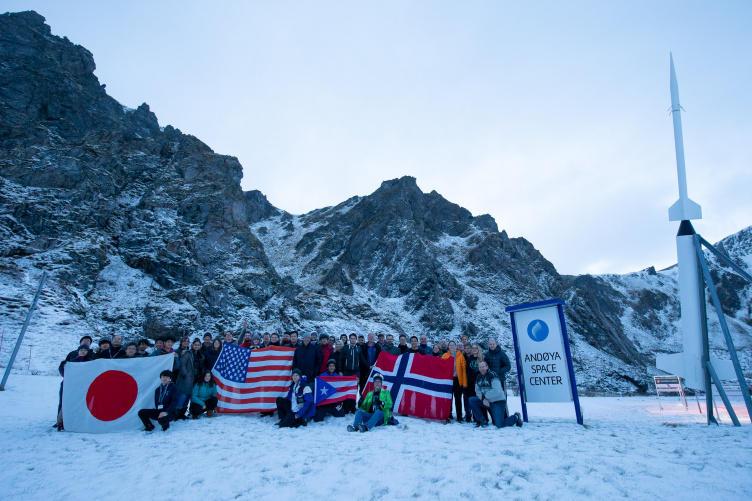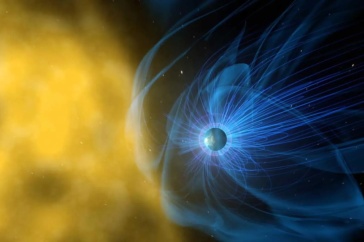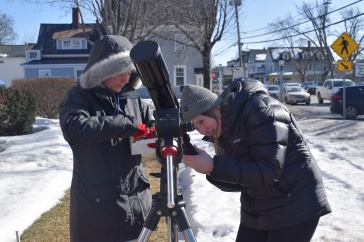
Students from Japan, Norway, the United States and Puerto Rico stand next to the rocket that helped them study the aurora above the Arctic Circle. Photo courtesy of NASA/Chris Perry.
Earlier this year, beneath the frigid, twilight skies near the Arctic Circle in Norway, a large rocket blasted off from a landing pad flanked by snow-capped peaks. An international group of students, including two from UNH, watched as the rocket soared into the upper atmosphere, carrying with it scientific instruments designed to sample the skies where northern lights dance.
UNH physics professor Marc Lessard and his students are studying one particular type of the northern lights called pulsating auroras to learn more about their contributions to nitrogen oxide (NOx) — a greenhouse gas — formation in the upper atmosphere.

Charged particles collide with gases like oxygen and nitrogen in the Earth’s atmosphere to create auroras, the colorful displays of light close to the North and South Poles. Pulsating auroras are sometimes more difficult to see with the naked eye, a barely perceptible, seconds-long tempo that pulses between a dim glow and total darkness. Lessard describes them as thin pancakes of light that stretch 100 km or more across the sky.
Pulsating auroras occur almost continuously, and scientists hypothesize that they trigger a series of chemical reactions forming NOx in the upper atmosphere. If the data from this research indicate there is indeed a connection between pulsating auroras and NOx production, scientists like Lessard theorize this phenomenon could be contributing to widespread, low-level ozone layer depletion.
“Data from this mission alone will not be enough to close the loop on this question, but it’s an important step to take nonetheless,” Lessard says.
To that end, Naomi Wight ’21 and Tyler Chapman ’18 spent the last year designing and building an instrument called a photometer, a small rectangular device intended to measure NOx near the pulsating aurora. The photometer was affixed to a NASA rocket at the Andøya Space Center in Andenes, Norway, where it launched into the auroras high above Earth.
“I just kept thinking, ‘Is this real?’” Wight says of the launch. “I was happy, sad, nervous, excited — all these emotions rushed through me when it finally blasted off.”
Early in the rocket’s flight, Wight and Chapman monitored the atmospheric conditions and the photometer’s vital signs to make sure everything was working properly. But 34 seconds after liftoff, something strange happened: The data seemed to stop coming in, the system tried to reboot itself, then stopped again. Wight and Lessard are in the process of now trying to figure out what happened, but Lessard suspects there was an electrical fault somewhere else in the payload.
“I’ve always been interested in space, and now I’m learning skills I wouldn’t have gotten in the classroom.”
The UNH photometer wasn’t the only scientific instrument aboard the rocket that recently launched; scientific instruments designed by student researchers from other institutions in the U.S., Norway, and Japan were also aboard to conduct other studies in the aurora. The same power snafu seems to have affected the other instruments, Wight explains. That doesn’t necessarily mean the team won’t have any usable data, though — they’ll comb through it in the coming months in hopes of learning all they can about the pulsating auroras.
Provided all goes well with that process, Lessard says the data from this mission will be used to form the basis for a new project proposal to expand on what the team has learned so far. He emphasizes the importance of getting undergraduate students involved in research of this caliber.
“Rockets are part of NASA’s Low-Cost Access to Space Program, which provides exceptional student learning opportunities,” he says. “It’s a tough business and it can be stressful, but this is groundbreaking work and it’s a great opportunity for the students’ careers.”

Naomi Wight '21 helped to build the photometer used in the rocket launch.
Wight and Chapman have both been involved in the newly formed UNH engineering physics bacherlor’s degree program, an interdisciplinary curriculum composed of electrical, mechanical and computer engineering as well as physics topics. Chapman came up with the photometer design while on a UNH International Research Opportunity for nine weeks at the University of Oslo in 2017. He is currently in Norway on a Fulbright Scholarship to study earthquakes.
Wight, who is originally from Lyndeborough, New Hampshire, learned instrumentation fabrication techniques, including how to solder, in UNH’s Morse Hall to construct a circuit board for the photometer. Last August, she went to NASA’s Wallops Island in Virginia for “integration,” where scientists test the instruments they’ve designed to make sure they work properly and make adjustments prior to the launch. The photometer worked well at integration, which paved the way for Wight’s travel to Norway to watch the rocket launch.
Despite the issues during the launch, Wight says she has enjoyed the balance of data analysis and instrument fabrication — the combination of using her brain and her hands is appealing and provides experience that she can carry with her in her future career.
“I’ve always been interested in space, and now I’m learning skills I wouldn’t have gotten in the classroom,” she says. “It’s very cool.”
The Institute for the Study of Earth, Oceans, and Space (EOS) is UNH’s largest research enterprise, comprising five centers with a focus on interdisciplinary, high-impact research on Earth and climate systems, space science, the marine environment and seafloor mapping. With more than $43 million in external funding secured annually, EOS fosters an intellectual and scientific environment that advances visionary scholarship and leadership in world-class research and graduate education.
-
Written By:
Rebecca Irelan | Institute for the Study of Earth, Oceans, and Space | rebecca.irelan@unh.edu | 603-862-0990

















































